| fl c. 450s BC |
Antenor II ? |
Legendary leader of the Cimmerians on the Black Sea coast. |
| Marcomer I ? / Marcomiro |
|
|
| Antenor III |
|
|
| Priamus |
|
|
According to later Frankish legend, in honour of the mother of Priamus the Cimmerians change the name of their tribe to Sicambri (or, more probably, something closely resembling Cambri, which would suggest that there is no name change at all - Cambri/Cimbri is close enough to Cimmeri for this to be the very source of the later false link to the Germanic Sicambri). Whilst the link to the Sicambri can be discarded, this does seems to point to a specific tribe of Cimmerians rather than all Cimmerians. As for the migration story, this is likely to be an invention to explain to a medieval audience the similarity between the Cambri and Cimmeri names. 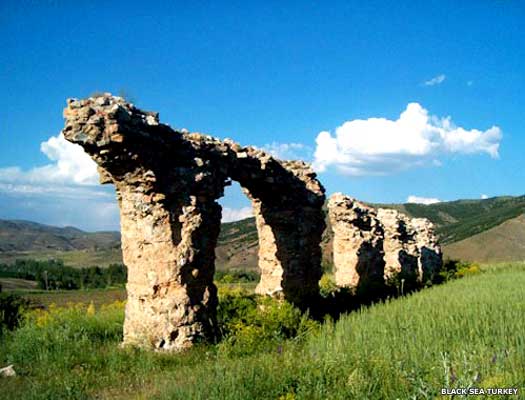 The coast around the Black Sea was claimed as the original homeland of the Franks by later, medieval authors, further obscuring an already legendary origin in Scandinavia The coast around the Black Sea was claimed as the original homeland of the Franks by later, medieval authors, further obscuring an already legendary origin in Scandinavia |
|
|
| Helenus |
|
|
| Diocles |
|
|
| Bassianus Magnus |
|
|
| Chlodomer I |
|
|
| Nicanor |
|
|
| Marcomer II |
|
|
| Chlodio I |
|
|
| Antenor II |
|
|
| Chlodomer II |
|
|
| Merovech |
|
|
| Cassander |
'Father' of Antharius. |
|
| c.60 BC |
From Antharius and Franco onwards, the genealogy of the Sicambri assumes an air of increased reality, although it is entirely uncertain whether any of these people ruled, or even existed. However, the Greek-inspired addition of Antenor IV aside, many of the names probably do represent real leaders. By this time the Sicambri have migrated into the forests of Germany and to the east bank of the Rhine, where Antharius fends off the military attentions of Julius Caesar. |
|
| c.60s? - 39 BC |
Antharius (I) |
King of the Sicambri. Withstood attack by Caesar. Died 39/37 BC. |
| 55 BC |
As recorded by Julius Caesar in his work, Commentarii de Bello Gallico, the Germanic Tencteri and Usipetes tribes are driven out of their tribal lands in Germania by the militarily dominantSuevi. Their wanderings bring them to the mouth of the Rhine, in the territory of theBelgic Menapii, who are located on both sides of the river. The Germans attack them, forcing them to withdraw to the western side of the Rhine, where the Menapii are able to defend the river line for some time. They also attack the Condrusi and Eburones tribes. Feigning a withdrawal to lure out the Menapii, the Tencteri and Usipetes defeat them, capture their ships and occupy many of their villages for the winter. Caesar, alarmed at this threat to the north of territory in Gaul that he has already conquered, takes a force into the region. After much diplomatic effort and some delays, he attacks the Germanic tribes and drives them back into Germania with heavy losses. Both tribes follow the east bank of the Rhine upstream and find refuge with the Sicambri. They remain settled in these lands for much of the remainder of their existence. Caesar crosses the Rhine to follow them and to show the Germans that Romans are not afraid to stage a counter-invasion. Another reason is that a portion of the cavalry of the Usipetes and Tencteri had not been present at the recent battle. Instead they had proceeded to the territories of the Sicambri to join this tribe, remaining defiant. Several other tribes submit to Caesar, but the Sicambri withdraw from their territories on the advice of the Usipetes and Tencteri. Caesar remains in their lands for a few days before burning down their villages and taking their corn. |
|
| 53 BC |
Caesar enters the country of the Eburones, forcing the rebellious Ambiorix to flee and his co-ruler to commit suicide. Despite this apparent capitulation, the country of the Eburones proves difficult for the Romans, so Caesar invites the neighbouring people to come and plunder the tribe and, after stubborn resistance, Caesar burns every village and building that he can find in their territory, drives off all the cattle, and confiscates all of the tribe's grain. The Sicambri take the opportunity to cross the Rhine and surprise many of the plunderers, seizing a large part of the Eburones' cattle. 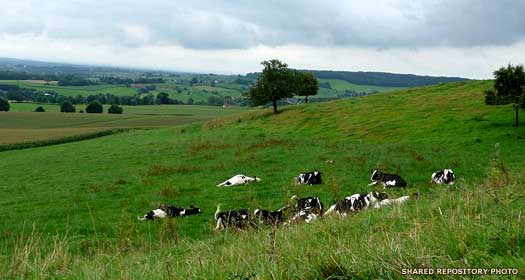 The gentle rolling landscape of the Limberg region would have made idea pasture and farming land for the Belgic tribes, but its proximity to the Maas would have provided the woods and swamps which served as a refuge in times of need The gentle rolling landscape of the Limberg region would have made idea pasture and farming land for the Belgic tribes, but its proximity to the Maas would have provided the woods and swamps which served as a refuge in times of need |
|
| Emboldened by their sudden gains, the Sicambri are easily persuaded to attack the main Roman camp with the promise of further riches and little opposition from the small garrison and a large number of invalids. After being surprised, the Roman defenders manage to rally under Sextus Baculus. They are reinforced by the returning foraging party and the Sicambri withdraw, seeing that they will not now prevail. They withdraw across the Rhine with their plunder and Caesar is able to settle his men into winter quarters. |
|
|
| fl c.37 BC |
Franco / Francus |
Possibly a real leader of the Sicambri? 'Son' of Antharius. |
| Chlodio II |
Possibly real or a legendary name. |
|
| Marcomer III |
Possibly real or a legendary name. |
|
| 26 BC |
Farther to the south and east in Europe, with Celts now inhabiting the most inhospitable and least desirable parts of Thrace, they appear to pose no threat to Rome. Their steadfast refusal to acknowledge Rome's rule and send recruits to serve in the Roman army is a threat, however. A Roman legion led by Pomponius Labeo arrives from Moesia to join the one in Thrace, and Sicambri cohorts are added to the force. The Thracian King Roimitalkes I of Sapes also supplies a body of auxiliaries from the Odrissae, amounting to a sizeable army to deal with the Celts. |
|
| fl 16 BC |
Melo |
Leader of the Sugambri according to Strabo. |
| 16 BC |
Melo organises a raid and defeats a Roman army under the command of Marcus Lollius, which sparks a reaction from the empire and helps to trigger a series of wars against Germanic tribes. Later the Sicambri under Deudorix, son of Baetorix, join the rebellion of Arminius (in AD 9). As well as mentioning Melo, Strabo also names the same 'Deudorix, a Sugambrian, the son of Baetorix the brother of Melo...' All of these names are Gaulish not Germanic. Clearly the German tribes that live along the banks of the Rhine are already very mixed with the Gauls or, more probably, theBelgae who have always exhibited some level of Germanic influence. Again, the Sicambri themselves could also be Belgic in origin. |
|
| fl 16 BC |
Baetorix |
Brother. |
| 12 - 9 BC |
The second century AD Roman historian Flores notes that the Cherusci, Sicambri, and Suevi have formed an alliance by crucifying capturedRoman centurions. Cassius Dio relates that Nero Claudius Drusus Germanicus, stepson of Emperor Augustus, is appointed governor of the Rhine region of Gaul and undertakes four campaigns against the Germanic tribes. After building a fortress on the island of theBatavi and defeating the[Frisii](FranceHolland.htm#Friso Kings), he undertakes some difficult fighting in which he is generally successful, subduing the Chauci near the mouth of the Weser. In 11 BC, he conquers theBructeri, Usipetes andMarsi, extending Roman control into the Upper Weser. In 10 BC, he launches a campaign against the Chatti and the resurgent Sicambri, subjugating both. The following year he conquers the Mattiaci, while also defeating the Marcomanni and Cherusci, the latter being taken care of near the Elbe. Drusus is killed in a fall from his horse during his fourth campaign, and his death deprives Rome of one its best generals. |
|
| fl AD 9 BC |
Deudorix |
Son. Leader of the Sicambri. |
| AD 9 - 21 |
Arminius declares the independence of the Cherusci from Rome, decimating three legions in the Teutoberger Forest. He achieves this momentous victory in an alliance with the Bructeri, Chatti, Chauci, Marsi, and Sicambri. In AD 15, Germanicus invades northern Germany and, following two Cherusci defeats in AD 16 (Idistaviso and the Battle of the Angrivarian Walls), Arminius is murdered in AD 21. 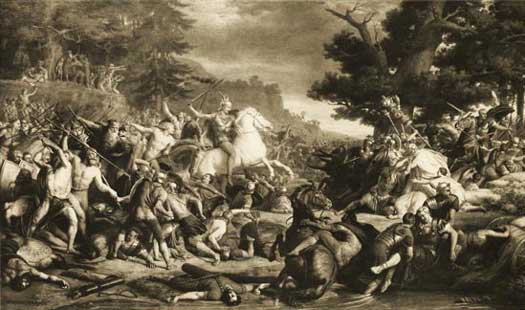 The decimation of three legions in the Teutoberger wald was a massive humiliation for the Roman empire and caused the abandonment of plans to conquer Germania Magna The decimation of three legions in the Teutoberger wald was a massive humiliation for the Roman empire and caused the abandonment of plans to conquer Germania Magna |
|
| Chlodomer III |
|
|
| Antenor IV |
Sicambrian Frank with Greek name. Probably added much later. |
|
| Rather |
|
|
| Richemer |
|
|
| Odomar |
|
|
| Marcomer IV |
|
|
| c.150 |
Ptolemy, who writes in the mid-second century, places the Sicambri to the south of a group of westerlySuevi Langobards, in the Rhineland. To their east are the Suevi Anglii, while along the Elbe are theChauci, to the east are the Semnones, and then there are the Suebi, perhaps the original core tribe of the confederation, which is apparently settled on the Rhine to the east of the Ems. |
|
| Chlodomer IV |
|
|
| Pharabert / Farabert |
|
|
| Sunno / Hunno |
|
|
| Hilderic |
|
|
| 3rd century |
The Germanic [Franks](FranceFranks.htm#Tribal Leaders) are first documented during this century (the Period of Migration), when they are to be found occupying territory on the Lower Rhine valley (on the east bank, in what is now northern Belgium and the southern [Netherlands](FranceHolland.htm#Kingdom of Holland %28Orange%29)). They are one of several West Germanic federations, and are formed of elements of the Ampsivarii, Batavi, Bructeri, Chamavi, Chatti, Chattuarii, Cherusci,[Salian Franks](FranceFranks.htm#Tribal Leaders), Sicambri, Tencteri, Tubantes, and Usipetes. Most of these peoples live along the Rhine's northern borders in what is becoming known as Francia. The fortunes of all of these tribes are now tied to the greater, and growing Frankish collective. |
|
| Barther |
|
|
| Chlodio III |
|
|
| Walter |
|
|
| 306 |
[Frankish](FranceFranks.htm#Tribal Leaders) leader Ascarich and his co-ruler lead a raid across the Rhine intoRoman southern Gaul, apparently breaking a previous agreement. They are defeated, captured, and executed in an amphitheatre by the simple means of allowing them and their followers to be torn apart by animals to the applause of the crowd. They are the first Frankish leaders to have their names recorded for posterity. It is possible that an invasion of the territory of the Bructeri in 308 is also part of the retaliation against the Frankish confederation for this attack. 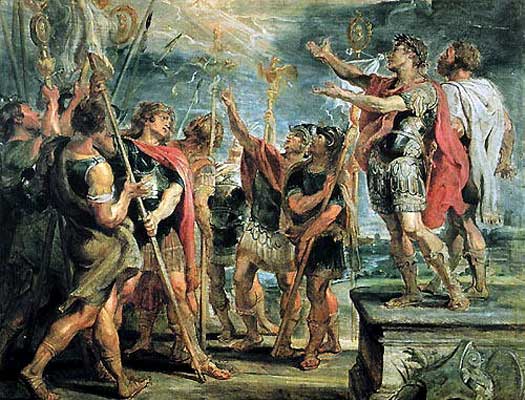 Emperor Constantine the Great is perhaps best known for confirming Christianity as the official religion of the Roman empire, but he also did a great deal to stabilise the empire and ensure that it survived into the next century Emperor Constantine the Great is perhaps best known for confirming Christianity as the official religion of the Roman empire, but he also did a great deal to stabilise the empire and ensure that it survived into the next century |
|
| Dagobert I |
Seemingly more realistic names begin to appear now. |
|
| Chlodomer |
|
|
| Richemer |
|
|
| Theodomer |
|
|
| 358 |
The [Salian](FranceFranks.htm#Tribal Leaders) Franks and their Batavi allies are accepted into the northern[Roman](ItalyRomeEmpire.htm#Julian the Apostate) empire by Julian the Apostate. Also in Gaul is Mallobaudes, another Frankish chief of unknown origin. Between 354 and at least 380, he serves in the Roman army, helping to defeat the Alemanni in 378 and killing Macrian, king of the Alemannic tribe of the Bucinobantes in 380. |
|
| fl c.360s/370s |
Chlodio IV |
|
| fl c.380s |
Dagobert |
|
| Dagobert is the last purely Sicambrian name to be listed. The next name in sequence in most lists is Gendobaud, one of three leaders of the[ Salian](FranceFranks.htm#Tribal Leaders) Franks at this time. This suggests that, however fanciful some elements of the list may be, all chroniclers accept that the Sicambri are now dominated by the Sali as the Frankish confederation grows in strength and numbers. |
|
|
| 388 |
Gendobaud, Sunno and Marcomer lead an invasion of [ Salian](FranceFranks.htm#Tribal Leaders) Franks into the [ Roman](ItalyRomeEmpire.htm#Flavians Secundas) provinces of Germania and Belgia. Their warriors break through the limes, destroying farmlands and killing people around the city of Cologne, before retreating across the border with their booty. Roman General Quintinus mounts a reprisal raid across the border but his troops are surrounded and beaten, and very few of them make it back. A later source suggests that after the death of Sunno, Marcomer attempts to unite the Frankish tribes by proposing his own son, Pharamond as the first king, or perhaps 'high king' would be more appropriate. His success or failure is unrecorded, but in the early fifth century, Pharamond is certainly regarded as the first (high) king of the Franks. From this point, rival Frankish divisions begin to be recorded, and the Sicambrian Franks themselves emerge more into history than the traditional genealogies of previous leaders can allow. The Salian Franks prove to be strong rivals to the Sicambri, although it appears that both branches soon merge under the Salian banner and follow a single, semi-legendary leader in the form of Merovée. |
|
| 406 |
By now relatively minor groups of Franks are settled on the west bank of the Rhine in various 'kingdoms' which cover areas of north-eastern Gaul, along with some groups of Suevi. They defend the Rhine against invading fellow Germans and remain a strong force in support of Rome for most of the century, and eventually, under Clovis, even strive to replace Rome as a European empire-builder. During the crossing of the Vandali (to avoid the Huns), the Franks attack this apparent threat to their own position. The Alani, also crossing the Rhine, come to the aid of the Vandali and save them from destruction. |
|
| 418 - 486 |
Roman government in the area centred on Soissons is maintained, even though the region becomes more and more isolated from Italy and surrounded by [Frankish](FranceFranks.htm#Tribal Leaders) states to the north-east and by theVisigoths to the south. From 461 it becomes fully independent in all but name. 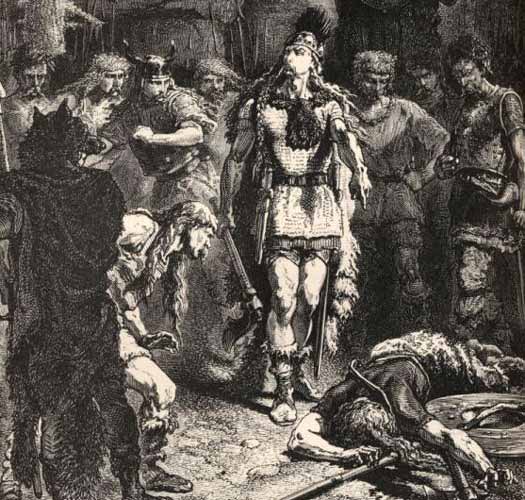 The Frankish conquest of Soissons in 486 allowed Clovis to plunder far and wide, slowly adding to his kingdom. A large vase stolen from the church at Rheims lead to a dispute between Clovis and one of his warriors, with the result that the latter was killed by the king The Frankish conquest of Soissons in 486 allowed Clovis to plunder far and wide, slowly adding to his kingdom. A large vase stolen from the church at Rheims lead to a dispute between Clovis and one of his warriors, with the result that the latter was killed by the king |
|
| 420 |
According toRoman historian Prosper Tiro, Pharamond (probable son of Marcomer) leads his people across the Rhine to settle on the west bank. As there are already Franks there (perhaps Sicambrian Franks), Pharamond's arrival could spell the first presence of the [Salian](FranceFranks.htm#Tribal Leaders) Franks inside the Roman empire. The Bructeri, along with the Tencteri, Tubantes, and Usipetes, do not migrate at all. Instead they remain in their traditional tribal lands and gradually coalesce into the more minor Ripuarian Franks who remain on the east bank of the Rhine. The Salian Franks remain dominant during the fifth century, while the Sicambrian Franks appear to fade out of the picture, suggesting their full integration within the Frankish mass as a supporting group. In the later years of the fifth century Clovis unites the Salian and Ripuarian Franks and creates the Merovingian kingdom. |
|
 |
|
|
 Sicambri / Sugambri (Germanic) The Germanic tribes seem to have originated in a homeland in southern Scandinavia (Sweden and Norway, with the Jutland area of northern Denmark, along with a very narrow strip of Baltic coastline). They had been settled here for over two thousand years following the Indo-European migrations. The Germanic ethnic group began as a division of the western edge of late proto-Indo-European dialects around 3300 BC, splitting away from a general westwards migration to head towards the southern coastline of the Baltic Sea. By the time the Germanic tribes were becoming key players in the politics of Western Europe in the last two centuries BC, the previously dominant Celts were on the verge of being conquered and dominated by Rome. They had already been pushed out of northern and Central Europe by a mass of Germanic tribes which were steadily carving out a new homeland. A West Germanic tribe, by the first century BC the Sicambri were a large group that was occupying territory on the east bank of the Rhine. This was between the rivers Lippe and Sieg and their junctions with the Rhine. In the medieval period the Sieg was known as the Sega or Segaha but was not mentioned by ancient writers. Even so, either the tribe or the river is likely to have gained its name from the other. To their north, across the River Lippe, were the Bructeri, to the east lay the Cherusci, to the south were the Chatti, and to the west were the Marsi, Tencteri, and Usipetes, while across the Rhine were the minor Cugerni, who were probably a splinter tribe. For the main part, the Segni tribe on the banks of the River Mosa is also thought to have been a splinter of the Sicambri, but with other elements added.
Sicambri / Sugambri (Germanic) The Germanic tribes seem to have originated in a homeland in southern Scandinavia (Sweden and Norway, with the Jutland area of northern Denmark, along with a very narrow strip of Baltic coastline). They had been settled here for over two thousand years following the Indo-European migrations. The Germanic ethnic group began as a division of the western edge of late proto-Indo-European dialects around 3300 BC, splitting away from a general westwards migration to head towards the southern coastline of the Baltic Sea. By the time the Germanic tribes were becoming key players in the politics of Western Europe in the last two centuries BC, the previously dominant Celts were on the verge of being conquered and dominated by Rome. They had already been pushed out of northern and Central Europe by a mass of Germanic tribes which were steadily carving out a new homeland. A West Germanic tribe, by the first century BC the Sicambri were a large group that was occupying territory on the east bank of the Rhine. This was between the rivers Lippe and Sieg and their junctions with the Rhine. In the medieval period the Sieg was known as the Sega or Segaha but was not mentioned by ancient writers. Even so, either the tribe or the river is likely to have gained its name from the other. To their north, across the River Lippe, were the Bructeri, to the east lay the Cherusci, to the south were the Chatti, and to the west were the Marsi, Tencteri, and Usipetes, while across the Rhine were the minor Cugerni, who were probably a splinter tribe. For the main part, the Segni tribe on the banks of the River Mosa is also thought to have been a splinter of the Sicambri, but with other elements added.  Also termed Sigambri or Sugumbri, the Sicambri name offers multiple choices when it comes to breaking it down (and it is unclear whether the name originally lay with the tribe or the River Sieg - see above). The word *sego is listed in the proto-Celtic list of words as meaning 'to hold, possess; to overcome someone, victory'. However, the use of 'victory' could be a later derivation, with 'to hold, possess' perhaps being earlier, and possibly being extended to refer to dominance or one-upmanship: 'I am better than you'. The core meaning could be one of boasting superior fighting skills (for a deeper examination, and one which perhaps doesn't entirely stick to the direction outlined above, see feature link, right). The Sicambri were one of the main branches of the powerful fourth century confederation known as the Franks. As with most Germans, their origins lay in the aforementioned Scandinavia and the northern reaches of mainland Europe, but later legend claimed a homeland for them in the region of the Black Sea. They gradually migrated to the Rhine and were first documented when they were to be found occupying territory on the Lower Rhine valley (on the east bank, in what is now northern Belgium and the southern [ Netherlands](FranceHolland.htm#Kingdom of Holland %28Orange%29)), during the third century (the Period of Migration). This unsettled period eventually forced the creation of several new alliances and confederations, with the Franks being one of the biggest of the latter. They were one of several West Germanic federations, and were formed of elements of the Ampsivarii, Batavi, Bructeri, Chamavi, Chatti, Chattuarii, Cherusci, [Frisii](FranceHolland.htm#Friso Kings),[Salians](FranceFranks.htm#Tribal Leaders), Sicambri, Tencteri, Tubantes, and Usipetes. Most of these peoples were already living along the Rhine's northern borders in what was becoming known as Francia. The Frankish realm underwent many partitions and changes of border, since the Franks divided their property among surviving sons and, lacking a broad sense of a res publica, they primarily conceived of their realm as a large swathe of private property. By the fifth century the Hetware (Hætwere) were closely associated with the Franks, perhaps following them down from the lower Netherlands where they seem originally to have been associated with the[Frisii](FranceHolland.htm#Offo Kings). The Lesser Frisians mentioned by Tacitus seem also to have migrated southwards with the Franks. This new 'kingdom' within rich Roman territory must have been quite enticing. Although at least three main branches of Franks were apparent by the fifth century, the only branch which seems to have retained a genealogy of any length was that of the Sicambrian Franks. In any realistic sense, this begins at the end of the first century BC when counting back from the earliest datable ruler, but before that point it goes back to a mythical Greco-Roman ancestry which was very much in fashion when Germanic genealogies were being embellished from the ninth century AD onwards. All of the legendary tribal leaders of the Franks are shown here with a lilac backing. (Information by Peter Kessler, with additional information by Edward Dawson, from The Oxford History of England: Roman Britain, Peter Salway, from The Oxford History of England: Anglo-Saxon England, Sir Frank Stenton, from The Odyssey, Homer, from Roman Soldier versus Germanic Warrior: 1st Century AD, Lindsay Powell, from Geography, Ptolemy, and from External Links: The Works of Julius Caesar: Gallic Wars, and Geography, Strabo (H C Hamilton & W Falconer, London, 1903, Perseus Online Edition).)
Also termed Sigambri or Sugumbri, the Sicambri name offers multiple choices when it comes to breaking it down (and it is unclear whether the name originally lay with the tribe or the River Sieg - see above). The word *sego is listed in the proto-Celtic list of words as meaning 'to hold, possess; to overcome someone, victory'. However, the use of 'victory' could be a later derivation, with 'to hold, possess' perhaps being earlier, and possibly being extended to refer to dominance or one-upmanship: 'I am better than you'. The core meaning could be one of boasting superior fighting skills (for a deeper examination, and one which perhaps doesn't entirely stick to the direction outlined above, see feature link, right). The Sicambri were one of the main branches of the powerful fourth century confederation known as the Franks. As with most Germans, their origins lay in the aforementioned Scandinavia and the northern reaches of mainland Europe, but later legend claimed a homeland for them in the region of the Black Sea. They gradually migrated to the Rhine and were first documented when they were to be found occupying territory on the Lower Rhine valley (on the east bank, in what is now northern Belgium and the southern [ Netherlands](FranceHolland.htm#Kingdom of Holland %28Orange%29)), during the third century (the Period of Migration). This unsettled period eventually forced the creation of several new alliances and confederations, with the Franks being one of the biggest of the latter. They were one of several West Germanic federations, and were formed of elements of the Ampsivarii, Batavi, Bructeri, Chamavi, Chatti, Chattuarii, Cherusci, [Frisii](FranceHolland.htm#Friso Kings),[Salians](FranceFranks.htm#Tribal Leaders), Sicambri, Tencteri, Tubantes, and Usipetes. Most of these peoples were already living along the Rhine's northern borders in what was becoming known as Francia. The Frankish realm underwent many partitions and changes of border, since the Franks divided their property among surviving sons and, lacking a broad sense of a res publica, they primarily conceived of their realm as a large swathe of private property. By the fifth century the Hetware (Hætwere) were closely associated with the Franks, perhaps following them down from the lower Netherlands where they seem originally to have been associated with the[Frisii](FranceHolland.htm#Offo Kings). The Lesser Frisians mentioned by Tacitus seem also to have migrated southwards with the Franks. This new 'kingdom' within rich Roman territory must have been quite enticing. Although at least three main branches of Franks were apparent by the fifth century, the only branch which seems to have retained a genealogy of any length was that of the Sicambrian Franks. In any realistic sense, this begins at the end of the first century BC when counting back from the earliest datable ruler, but before that point it goes back to a mythical Greco-Roman ancestry which was very much in fashion when Germanic genealogies were being embellished from the ninth century AD onwards. All of the legendary tribal leaders of the Franks are shown here with a lilac backing. (Information by Peter Kessler, with additional information by Edward Dawson, from The Oxford History of England: Roman Britain, Peter Salway, from The Oxford History of England: Anglo-Saxon England, Sir Frank Stenton, from The Odyssey, Homer, from Roman Soldier versus Germanic Warrior: 1st Century AD, Lindsay Powell, from Geography, Ptolemy, and from External Links: The Works of Julius Caesar: Gallic Wars, and Geography, Strabo (H C Hamilton & W Falconer, London, 1903, Perseus Online Edition).) The coast around the Black Sea was claimed as the original homeland of the Franks by later, medieval authors, further obscuring an already legendary origin in Scandinavia
The coast around the Black Sea was claimed as the original homeland of the Franks by later, medieval authors, further obscuring an already legendary origin in Scandinavia The gentle rolling landscape of the Limberg region would have made idea pasture and farming land for the Belgic tribes, but its proximity to the Maas would have provided the woods and swamps which served as a refuge in times of need
The gentle rolling landscape of the Limberg region would have made idea pasture and farming land for the Belgic tribes, but its proximity to the Maas would have provided the woods and swamps which served as a refuge in times of need The decimation of three legions in the Teutoberger wald was a massive humiliation for the Roman empire and caused the abandonment of plans to conquer Germania Magna
The decimation of three legions in the Teutoberger wald was a massive humiliation for the Roman empire and caused the abandonment of plans to conquer Germania Magna Emperor Constantine the Great is perhaps best known for confirming Christianity as the official religion of the Roman empire, but he also did a great deal to stabilise the empire and ensure that it survived into the next century
Emperor Constantine the Great is perhaps best known for confirming Christianity as the official religion of the Roman empire, but he also did a great deal to stabilise the empire and ensure that it survived into the next century The Frankish conquest of Soissons in 486 allowed Clovis to plunder far and wide, slowly adding to his kingdom. A large vase stolen from the church at Rheims lead to a dispute between Clovis and one of his warriors, with the result that the latter was killed by the king
The Frankish conquest of Soissons in 486 allowed Clovis to plunder far and wide, slowly adding to his kingdom. A large vase stolen from the church at Rheims lead to a dispute between Clovis and one of his warriors, with the result that the latter was killed by the king